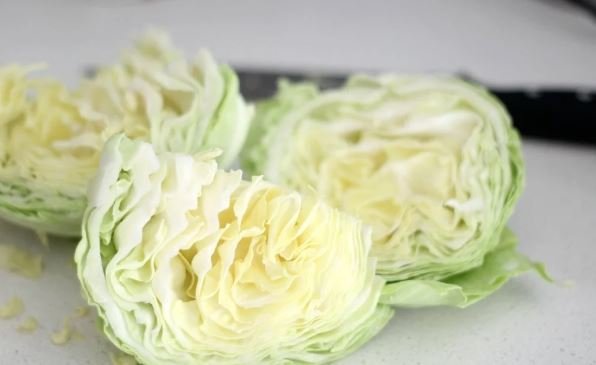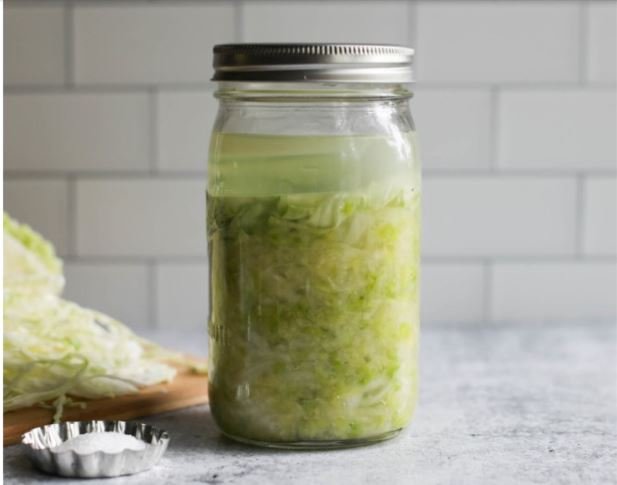How To Make Homemade Sauerkraut In A Jar
Sauerkraut is incredibly simple to make at home, and you only need two main ingredients, cabbage, and salt. Sauerkraut, another centuries-old fermented food with a sour flavour, is well known for being a good source of probiotics which promote healthy digestion.
Whether you have eaten it but never prepared it this guide will simplify the process of fermenting cabbage into sauerkraut in your jar!
Why Make Sauerkraut at Home?
Several reasons are making your sauerkraut from scratch is incredibly rewarding:
- It’s healthier: Homemade sauerkraut ferments naturally while store-bought varieties contain preservatives.
- It’s cost-effective: Sauerkraut is made from cabbage, salt, and a jar so you can make gallons of it for the price you would pay for just a few servings.
- It’s customizable: Adding different spices, veggies and other ingredients can alter the flavour to your liking.
Ingredients
- 1 medium cabbage (green or red)
- 1 tablespoon sea salt (non-iodized salt is recommended, as iodized salt can interfere with the fermentation process)

Instructions
Prepare the Cabbage
Begin by peeling off the tough outer leaves of the cabbage. These are usually the tougher chewed, admittedly. Reserve one clean large leaf for use later. Quarter the cabbage and core it. Then chop the cabbage into thin ribbons. The thinner you slice or dice it, the faster it will ferment.
Massage Salt into the Cabbage
Put the shredded cabbage in a large mixing bowl, and sprinkle with salt. With clean hands, massage the salt into the cabbage for about 5-10 minutes. This way the cabbage will start sweating out water. The reason for this is that we want the cabbage to ferment in its own brine. Massage until the cabbage starts to soften and there’s enough liquid in the bottom of your bowl.
Fill the Jar with Cabbage
Grab your wide-mouth jar and begin to pack the cabbage in, smashing it down as you do so. Make sure to pack the cabbage tightly, removing as many air pockets in there as you can. To shape, use your hands or a wooden spoon. Add any of the liquid that came out during massaging into the jar as well. For the cabbage to burble away below its brine.

Add the Cabbage Leaf
That cabbage leaf you saved? Place one on top of the shredded cabbage in your jar Doing so will keep the cabbage pieces under brine and prevent exposure to air, which could attract mold. Or use a fermentation weight or small jar that fits inside your bigger jar to weigh down the cabbage even more.
Cover and Ferment
Place a clean kitchen towel, cheesecloth or loose lid on the jar. This will keep the dust and insects away while letting air escape when cabbage ferments. Find one of your kitchen cabinets or pantry in which you can place this jar as it calls to sit at room temperature of 65-75°F (18-24°C) and out of direct sunlight.
Wait and Monitor
Allow the cabbage to ferment for 1-4 weeks. Fermentation time varies with temperature and taste preference. For the first couple of days, you may notice bubbles starting to appear as fermentation commences. Follow up the procedure by observing that cabbage is always covered with brine while it matures. If necessary, press it again to submerge it under the liquid.
Taste and Store
If it is taking longer, taste it after a week. Once you have achieved the right level of tartness, it is finished! Move the jar to the fridge and it will slow down on the fermentation. Sauerkraut lasts for months in the fridge, indeed even improving with ageing.

Variations of Homemade Sauerkraut Recipe
- Spicy Sauerkraut: along with tons of red pepper flakes using a few jalapeño or despised chilli peppers blended with the cabbage. The spice makes this version all about the heat and takes Mexican or Asian-inspired recipes to another level.
- Caraway Sauerkraut: Caraway seeds are a classic in sauerkraut and give a somewhat sweet, earthy taste. They add a little bit more acid to offset the tanginess of the sauerkraut and are extremely traditional in German recipes.
- Garlic and Dill Sauerkraut: Add 3-5 cloves of garlic and add fresh or dried dill to the cabbage. This version adds garlic so the sauerkraut has a garlicky, herbaceous taste.
- Beet and Cabbage Sauerkraut: For pinker kraut, shred beets into the cabbage for a slight sweetness.
- Apple and Cabbage Sauerkraut: Toss in thinly sliced apples with the cabbage before fermentation for a slightly sweeter alternative.
- Ginger and Turmeric Sauerkraut: Fresh ginger & turmeric grated with the cabbage in each layer for that anti-inflammatory boost. This has a warm, slightly spicy flavour that’s both healthy and delicious.
Tips and Tricks for Making the Best Sauerkraut
- Use fresh cabbage: The fresher the cabbage, the more liquid will get released while you massage it and this is key for fermentation.
- Keep it submerged: Your cabbage must be submerged beneath the brine or else it will not keep.
- Experiment with flavours:: Add things such as caraway seeds, juniper berries, garlic, and grated carrots for added flavour to your sauerkraut.
- Watch for bubbles: Bubbling lets you know the fermentation process is happening. The smell will be a little funny at first, but that’s completely fine.

Common Questions About Homemade Sauerkraut
- How do I know if my sauerkraut is fermenting properly?
The water will bubble a bit, it should smell tangy and if you have a tight-fitting lid the brine might become cloudy. All good indicators of fermentation! Remove mould if you see it on top. If the cabbage below the brine was not disturbed, then you have a safe and nutritious kraut.
- Can I use other vegetables in my sauerkraut?
Yes! Feel free to add vegetables such as carrots, beets or radishes to your sauerkraut. They, too, will ferment and add colour and a little flavour to your kraut.
- How long does homemade sauerkraut last?
Homemade sauerkraut can last for up to six months in the refrigerator. Or if you have the time, store it in a jar for at least 8 hours – its flavour will only get deeper and more complex as time passes.

Conclusion
This recipe for making sauerkraut in a jar at home is not difficult and very rewarding. Cabbage, a smidge of salt and some time is all you need to ferment up some tasty (and gut-friendly) sauerkraut that will only make your digestion better.
Not to mention, while you get the hang of it you can play with flavours and whatnot to make them your recipe. Your homemade sauerkraut can be used on salads, sandwiches or a great healthy snack!
